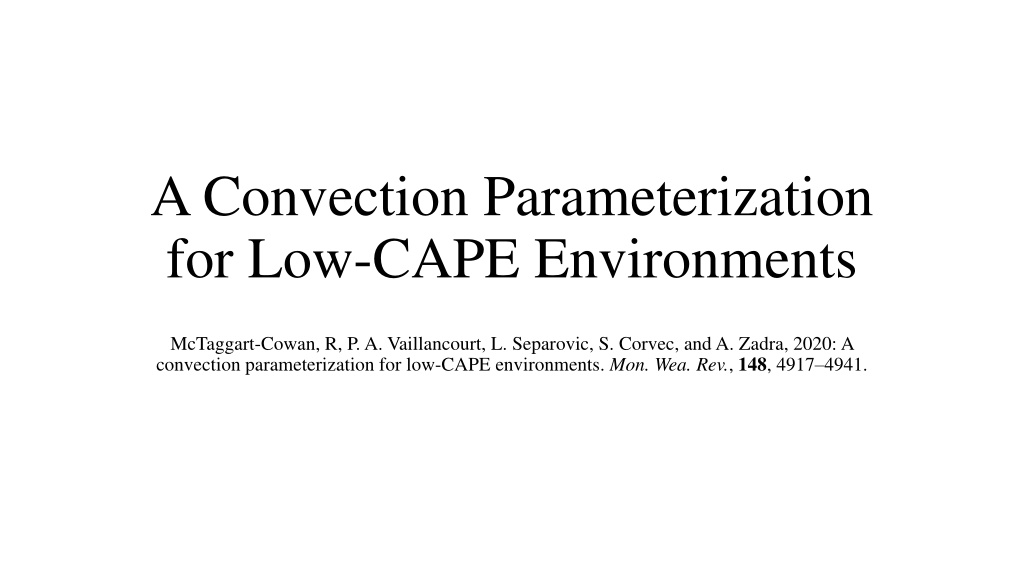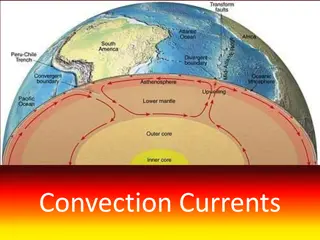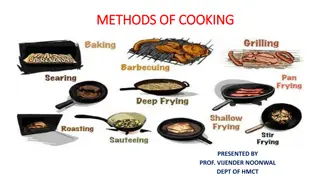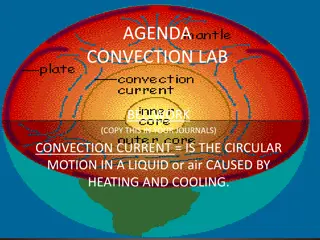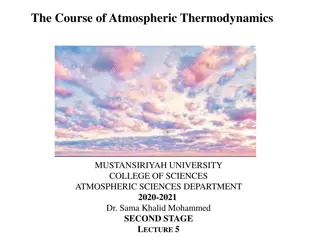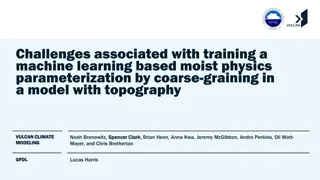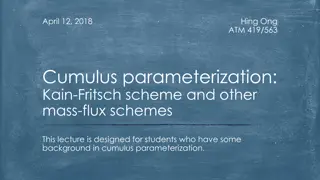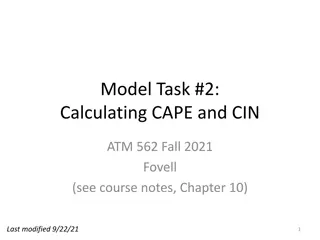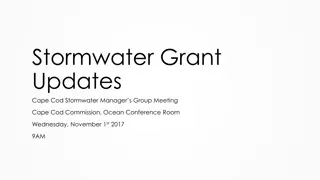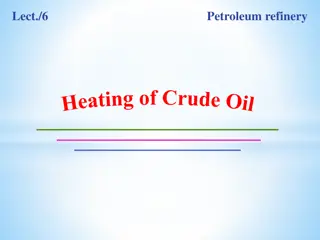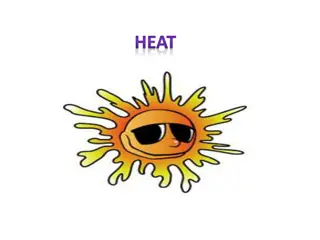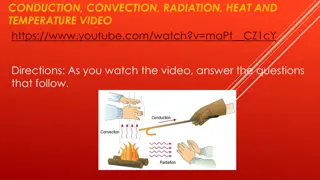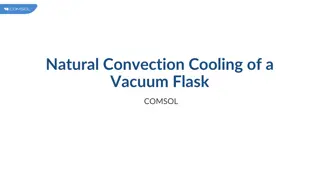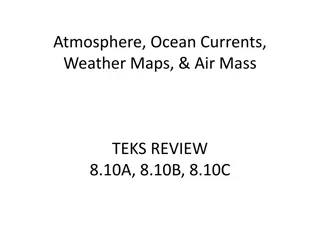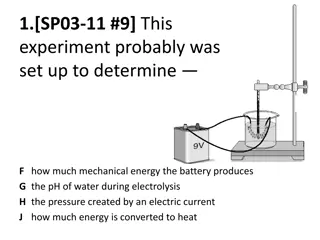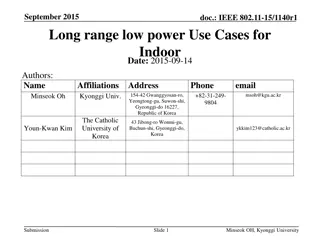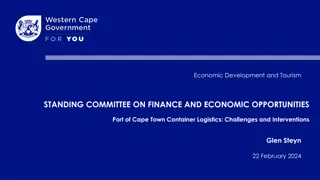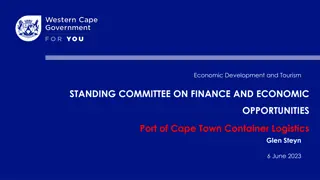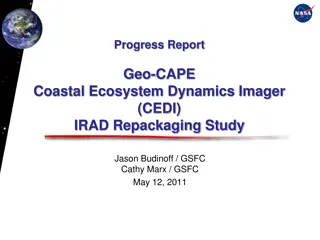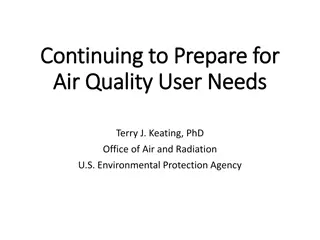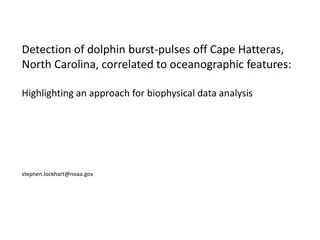Convection Parameterization for Low-CAPE Environments
Many global Numerical Weather Prediction systems face challenges predicting convective activity in low-CAPE environments. This study introduces a convection parameterization scheme based on moisture convergence to better represent convective effects. The scheme focuses on the triggering function, updraft speed, and density considerations in low-instability environments. Incorporating these factors can enhance the representation of convective activity in atmospheric models.
Download Presentation

Please find below an Image/Link to download the presentation.
The content on the website is provided AS IS for your information and personal use only. It may not be sold, licensed, or shared on other websites without obtaining consent from the author. Download presentation by click this link. If you encounter any issues during the download, it is possible that the publisher has removed the file from their server.
E N D
Presentation Transcript
A Convection Parameterization for Low-CAPE Environments McTaggart-Cowan, R, P. A. Vaillancourt, L. Separovic, S. Corvec, and A. Zadra, 2020: A convection parameterization for low-CAPE environments. Mon. Wea. Rev., 148, 4917 4941.
introduction Many of global NWP systems employ schemes that relate the deep convective activity directly to the convective available potential energy (CAPE) of the near-storm environment (Yano et al. 2013) The potential for vigorous moist convection in low-instability environments represents a predictability and detection challenge (McCann 1978; Vescio and Thompson 2001; Davis and Parker 2014). Convective activity in low-CAPE condition: Sufficient potential instability and moisture warm sectors and frontal boundaries of midlatitude cyclones (Jewett and Wilhelmson 2006; Clark 2009; Evans 2010). strong synoptic and mesoscale forcing for ascent in the pre-convective environment [van Den Broeke et al. (2005)]
precipitation bulls-eyes: the gridscale condensation scheme depicts latent heating at the base of the potentially unstable layer as the grid cell-averaged relative humidity nears saturation in the ascending airstream (Teixeira 2001; Quass 2012). Models that employ a class of convective schemes whose activity depend on moisture convergence (Bougeault 1985; Tiedtke 1989; Banacos and Schultz 2005) have the potential to represent better the effects of convection in low-CAPE environments. all relationships to the large-scale state weaken as model resolution increases.
A low-CAPE convection scheme (based on Tiedtke (1989) scheme)
Trigger function ?: density ?: model grid length ?0= 7 106??? 2 ? 1 10 6? 1 vertical wind speeds (w) can become large as gravitational or symmetric instabilities are released, particularly when the gridscale condensation scheme predicts latent heating in ascending airstreams. The justification for the scaling (f) is based on the presence of off- equatorial ascent driven by inertial instability(Tomas and Webster 1997).
A low-CAPE convection scheme (based on Tiedtke (1989) scheme) r = 500 m (Bechtold et al. 2001)
Updraft speed (??) : ??:virtual temperature ?: entrainment rate ?: 0.5 (empirically derived constant) : difference between two adjacent model levels (): an average over the same layer ??: the drag on updraft acceleration resulting from condensate loading Parcel buoyancy is generally small in low-CAPE profiles, cloud-base updraft speed (w LCL) that serves as the lower boundary condition plays an important role in determining the depth of the cloud layer.
A low-CAPE convection scheme (based on Tiedtke (1989) scheme) ????? ?????? ????? ???: ??= 0 (?/?) ????= 2000 (?)
downdraft The top of the downdraft [the level of free sink (LFS)]: minimum environmental saturation equivalent potential temperature initial downdraft mass flux: an extraction of updraft air scaled by precipitation efficiency (Ep) as ??:0.4 Between the LFS and the top of the detrainment layer, the downdraft grows through a constant fractional entrainment rate of 0.03 downdraft characteristics: 1. cold pool formation 2. potential secondary initiation
A low-CAPE convection scheme (based on Tiedtke (1989) scheme)
Closure ?LCL??2????= ?LCL???? ?2 ?????? = ?2 ??2cloud population size grid-scale vertical motion: convection. a key ingredient for low-CAPE
A low-CAPE convection scheme (based on Tiedtke (1989) scheme) Tendencies for gridscale variables: :gridscale variable
model description Global Environmental Multiscale (GEM) model: operational applications at the Canadian Meteorological Centre semi-Lagrangian dynamical core log-hydrostatic-pressure type (Girard et al. 2014). 0.09 ( ~10 km) grid spacing 300-s time step 84 levels Model top at 0.1-hPa Physical parameterizations (McTaggart-Cowan et al. 2019a): gridscale condensation scheme: Sundqvist 1978) Convection scheme: include the shallow and midlevel convection schemes [Bechtold et al. (2001)]
Data In situ data: radiosonde and surface observations available over the Global Telecommunication System. Precipitation: Multi-Radar Multi-Sensor (MRMS) system ERA-Interim (0.5 degree; Dee et al. 2011) higher-resolution ERA5 (0.25 degree; Hersbach et al. 2018) for the analysis of mesoscale structures
Heavy precipitation case study surface Heights (contours), winds and wind speeds (color) at 250 hPa Ontario, Pickle Lake sounding station Quebec Aberdeen station Ontario: isolated convective cells midwestern United States: long-lived squall line
Isolated convection in northern Ontario Quantitative precipitation estimates (color; in mm/h) from the MRMS dataset Pickle Lake sounding station
0000 UTC 6 July Pickle Lake sounding station the baroclinic zone near 850 hPa 1. ample moisture for convection 2. warm advection ( frontal overrunning ) 3. attendant quasigeostrophic forcing for ascent. nearly moist adiabatic above 850-hPa (devoid of CAPE) drying in the 750 550-hPa layer leads to a negative vertical gradient in ??(potential instability)
near-storm environment averaged over the 850750-hPa layer at 00UTC 6 Jul 2016 Red line: RH>70% green line: frontogenesis > 0 ( K m-1s-1) Blue line: ??? ??> 0
Precipitation rate (mm/hr) at 0000 UTC 6 Jul 2016 over the northern Ontario region Black line: the track of the precipitation maximum with hourly markers
Time series of maximum total (solid) and convective (dashed) precipitation rates following the convective event
Squall line in the midwestern United States Quantitative precipitation estimates (color; in mm/h) from the MRMS dataset
Aberdeen sounding for 1800 UTC 5 Jul 150 km to the west of the convective initiation cold northerly flow undercuts the warmer air above the 850-hPa frontal inversion to create large CIN (-300 J kg-1). ??? ??= 10 ? ??????? 850 ??? 650 ?? synoptic scale ascent (jet entrance region) initially elevated cells cold pool mesoscale ascent surface- based deep convection Morris Municipal Airport (KMOX): cloud bases ~ 700 hPa, consistent with parcels that have undergone forced ascent from above the frontal inversion
Time observations at La Crosse, Wisconsin series of surface METAR a robust cold pool is evident at the surface
SIMULATED EVOLUTION CTL simulation black contour: position of the observed squall line
Low-CAPE convection scheme (LC) LC simulation
For low-CAPE convection scheme Contours: Subgrid-scale precipitation rate (mm/hr) Color: Remainder of precipitation
Cold pool enhancement after 2 h of integration, valid at 2300 UTC 5 Jul 2016 Red-stippled: Vertical motion enhancement (LC- CTL>0.5 Pa/s) at the 0.85 hybrid-coordinate model level shaded: Total accumulated precipitation (mm) Color: LC-CTL screen-level temperatures (K)
Color: difference in temperature between LC and CTL at the 0.85 hybrid-coordinate model level black contour: position of the observed squall line
Impact on NWP guidance July-August 2016 period
Precipitation scores for day-2 24-h accumulations (24 48-h forecast time) over North America from 1200 UTC initializations in the summer 2016 forecast sequence (21 cases total) OBS Y N FCST Y H F N M O ? False alarm ratio = ?+? ? probability of detection = ?+? frequency bias = ?+? ?+?
North American near-surface scores from 1200 UTC initializations in the summer 2016 forecast sequence (21 cases total) (2-m) Observations: combination of the synoptic and METAR networks dashed lines: bias Solid lines: error standard deviation (2-m) (10-m)
profile of error standard deviation and bias against NorthAmerican radiosonde observations dashed lines: bias Solid lines: error standard deviation
Conclusions Low-CAPE convection scheme: connection of triggering and closure components to the gridscale vertical motion release instabilities in low-CAPE environments improve precipitation structure under low-CAPE conditions (precipitation bull s-eyes are eliminated) enhanced cold pool improvements in guidance skill a particularly strong relationship between M? quantitative precipitation forecasts. model s long-standing positive precipitation bias has been over reduced in convectively active regions. ???(triggering) and
Models that employ a class of convective schemes whose activity depend on moisture convergence (Bougeault 1985; Tiedtke 1989; Banacos and Schultz 2005) have the potential to represent better the effects of convection in low-CAPE environments. This assertion is supported by results of Suhas and Zhang (2015), who conclude that closures based on this quantity yields the highest correlation with observed convection however, they note that all relationships to the large-scale state weaken as model resolution increases. Schemes that are particularly well suited to represent the release of potential instability are those that can act in low-CAPE environments in response to elevated synoptic and mesoscale forcings for ascent. Such midlevel convection schemes are employed in operational systems run at both ECMWF (Tiedtke 1989) and UKMO (Gregory and Rowntree 1990); however, their impact on predictions of convection and overall guidance quality have not been documented extensively in the literature.
ABSTRACT Most of cumulus schemes are designed to represent the dominant class of cumulus convection that is driven by latent heat release in a conditionally unstable profile with a surplus of convective available potential energy (CAPE). an important subset of events occurs in low-CAPE environments in which potential and symmetric instabilities can sustain moist convective motions. Case studies show that the scheme eliminates the bull s-eyes in precipitation guidance that develop in the absence of parameterized convection, and that it can represent the initiation of elevated convection that organizes squall-line structure.
A low-CAPE convection scheme The formulation of the low-CAPE convection scheme described here is based loosely on the ECMWF (2018) description of the midlevel variant of the Tiedtke (1989) scheme. The utility of such a Lagrangian updraft model in low-CAPE environments was first demonstrated by Kreitzberg and Perkey (1976), who investigated the parameterization of moist convection in the presence of potential instability. To avoid the double-counting of moist convective effects, the new scheme is only tested for possible activity where CAPE values are below 250 J kg 2 1. This limit that is more restrictive than the 500 J kg 2 1 typically used to identify HSLC events (Sherburn and Parker 2014) Unlike HSLC severe storm studies; however, no wind shear condition is applied because the intent of the scheme is to represent the full range of low-CAPE convective intensities
Lateral mixing (? ??? ?) is represented in the low-CAPE scheme using the buoyancy sorting technique introduced by Kain and Fritsch (1990) A zone of forced detrainment lies above the level of neutral buoyancy (???= ??), followed by the overshooting cloud top where ??= 0 ?? 1. Over this layer, the updraft horizontal momentum is adjusted to account for the pressure gradient across the ascending plume (Gregory 1996), as described for the model s deep convection scheme by McTaggart-Cowan et al. (2019b). A minimum cloud depth of 2000 m is required for this form of precipitating convection (Niziol et al. 1995; Kain 2004), with shallower prototypes failing this component of the trigger requirement for precipitating convection and returning for further evaluation (section 3a) until the potential triggering level exceeds 10 km above ground (ECMWF 2018).
